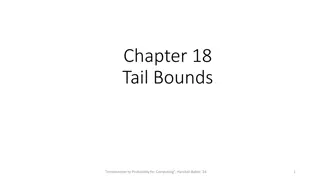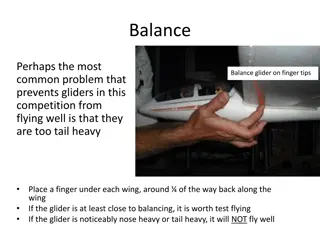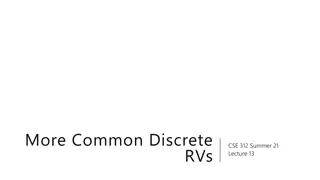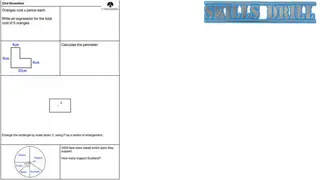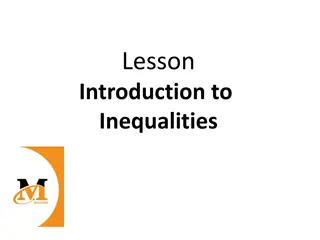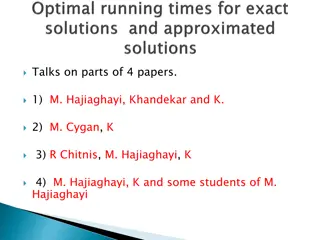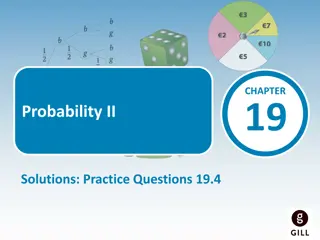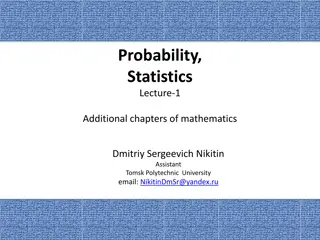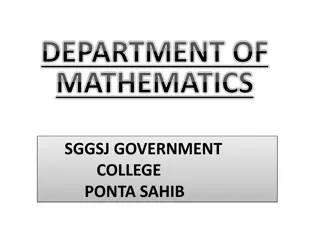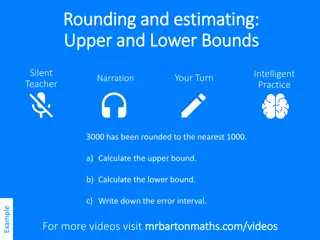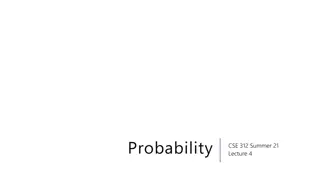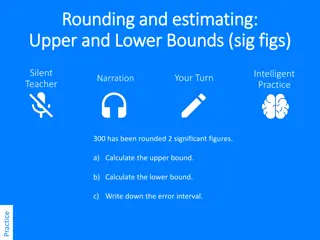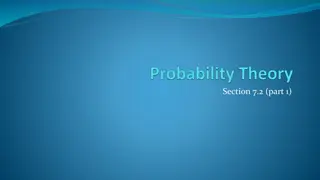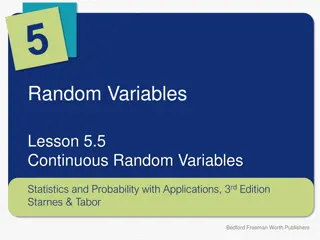Understanding Tail Bounds and Inequalities in Probability Theory
Explore concepts like Markov's Inequality, Chebyshev's Inequality, and their proofs in the context of random variables and probability distributions. Learn how to apply these bounds to analyze the tails of distributions using variance as a key parameter. Delve into examples with geometric random variables to understand practical applications of these inequalities.
Download Presentation

Please find below an Image/Link to download the presentation.
The content on the website is provided AS IS for your information and personal use only. It may not be sold, licensed, or shared on other websites without obtaining consent from the author. Download presentation by click this link. If you encounter any issues during the download, it is possible that the publisher has removed the file from their server.
E N D
Presentation Transcript
Tail Bounds 2 CSE 312 Spring 21 Lecture 22
Announcements Final logistical information coming to Ed in the next two days. Pset 6 grades back. Trying an experiment regrade requests will open tomorrow. Real World 2 is out, due Tuesday June 1. Pset 8 out tonight (due in one week)
Our First bound Two statements are equivalent. Left form is often easier to use. Right form is more intuitive. Markov s Inequality Markov s Inequality Let ? be a random variable supported (only) on non-negative numbers. For any ? > ? ? ? ?[?] Let ? be a random variable supported (only) on non-negative numbers. For any ? > ? ? ??[?] ? ? ? To apply this bound you only need to know: 1. it s non-negative 2. Its expectation.
Sowhat do we do? A better inequality! We re trying to bound the tails of the distribution. What parameter of a random variable describes the tails? The variance!
Chebyshevs Inequality Two statements are equivalent. Left form is often easier to use. Right form is more intuitive. Chebyshev s Inequality Chebyshev s Inequality Let ? be a random variable. For any ? > ? ? ???(?) Let ? be a random variable. For any ? > ? ? ?? ? ? ? ? ??? ? ? ? ? ??
Proof of Chebyshev Chebyshev s Inequality Let ? be a random variable. For any ? > ? ? ???(?) ? ? ? ?? Let ? = ? ? ? Markov s Inequality ? ? = 0 ? ?2 ?2 ? ?2 ? ? 2 =Var ? =Var(?) |?| ? = ?2 ?2 = ?2 ?2 ?2 Inequalities are equivalent (square each side). ? is just ? shifted. Variance is unchanged.
Example with geometric RV Suppose you roll a fair (6-sided) die until you see a 6. Let ? be the number of rolls. Bound the probability that ? 12 Chebyshev s Inequality Let ? be a random variable. For any ? > ? ? ???(?) ? ? ? ??
Example with geometric RV Suppose you roll a fair (6-sided) die until you see a 6. Let ? be the number of rolls. Bound the probability that ? 12 5/6 1/36 62=5 ? 12 ? 6 6 6 Chebyshev s Inequality Let ? be a random variable. For any ? > ? ? ???(?) Not any better than Markov ? ? ? ??
Example with geometric RV Let ? be a geometric rv with parameter ? Bound the probability that ? 2 ? 1 ? ?2 1/?2= 1 ? ? 2/? ? 1/? 1/? Markov gives: Chebyshev s Inequality 2 ? =? ? 1 ? ? 2=1 Let ? be a random variable. For any ? > ? ? ???(?) 2. ? 2/?= For large ?, Chebyshev is better. ? ? ? ??
Better Example Suppose the average number of ads you see on a website is 25. And the variance of the number of ads is 16. Give an upper bound on the probability of seeing a website with 30 or more ads.
Better Example Suppose the average number of ads you see on a website is 25. And the variance of the number of ads is 16. Give an upper bound on the probability of seeing a website with 30 or more ads. ? 30 ? 25 5 16 25
Near the mean Suppose you run a poll of 1000 people where in the true population 60% of the population supports you. What is the probability that the poll is not within 10-percentage-points of the true value? ? = ??/1000 ? ? = 1000 1000=3 .6 .4 10002= .6 5 Chebyshev s Inequality Let ? be a random variable. For any ? > ? ? ???(?) Chebyshev s Inequality 3 Var ? = 1000 12500 ? ? ? ??
Near the mean Suppose you run a poll of 1000 people where in the true population 60% of the population supports you. What is the probability that the poll is not within 10-percentage-points of the true value? ? = ??/1000 ? ? = 1000 1000=3 .6 .4 10002= .6 5 Chebyshev s Inequality Let ? be a random variable. For any ? > ? ? ???(?) Chebyshev s Inequality 3 Var ? = 1000 12500 ? ? ? ??
Near the mean Suppose you run a poll of 1000 people where in the true population 60% of the population supports you. What is the probability that the poll is not within 10-percentage-points of the true value? ? = ??/1000 ? ? = 1000 1000=3 .6 .4 10002= .1 3/12500 .6 5 Chebyshev s Inequality Let ? be a random variable. For any ? > ? ? ???(?) Chebyshev s Inequality 3 Var ? = 1000 12500 = .024 ? ? ? .12 ? ? ? ??
Chebyshevs Repeated Experiments How many coin flips (each head with probability ?) are needed until you get ? heads. Let ? be the number necessary. What is probability ? 2?/?? Markov Chebyshev
Chebyshevs Repeated Experiments How many coin flips (each head with probability ?) are needed until you get ? heads. Let ? be the number necessary. What is probability ? 2?/?? Markov ? 2? ?/? 2?/?=1 ? 2 ?2/?2=?(1 ?)/?2 Chebyshev ? 2? ? ? ? ? Var(?) =1 ? ?2/?2 ? ? ?
Takeaway Chebyshev gets more powerful as the variance shrinks. Repeated experiments are a great way to cause that to happen.
More Assumptions Better Guarantee (Multiplicative) Chernoff Bound Let ?1,?2, ,?? be independent Bernoulli random variables. Let ? = ??, and ? = ? ? . For any 0 ? 1 ? 1 + ? ? exp ?2? and ? 1 ? ? exp ?2? 3 2
Same Problem, New Solution Suppose you run a poll of 1000 people where in the true population 60% of the population supports you. What is the probability that the poll is not within 10-percentage-points of the true value? (Multiplicative) Chernoff Bound Let ?1,?2, ,?? be independent Bernoulli random variables. Let ? = ??, and ? = ? ? . For any 0 ? 1 ? 1 + ? ? exp ?2? and ? 1 ? ? exp ?2? 3 2
Right Tail Suppose you run a poll of 1000 people where in the true population 60% of the population supports you. What is the probability that the poll is not within 10-percentage-points of the true value? ? Want 1000 .7 = (? .7 1000) = ? 1 + .1/.6 (.6 1000) So ? =1 Chernoff Bound (right tail) Let ?1,?2, ,?? be independent Bernoulli random variables. Let ? = ??, and ? = ? ? . For any 0 ? 1 ? 1 + ? ? exp ?2? 6 and ? = .6 1000 1 62 .6 1000 3 ? 700 exp 0.0039 3
Left Tail Suppose you run a poll of 1000 people where in the true population 60% of the population supports you. What is the probability that the poll is not within 10-percentage-points of the true value? ? Want 1000 .5 = (? .5 1000) = ? 1 .1/.6 (.6 1000) So ? =1 Chernoff Bound (left tail) Let ?1,?2, ,?? be independent Bernoulli random variables. Let ? = ??, and ? = ? ? . For any 0 ? 1 ? 1 ? ? exp ?2? 6 and ? = .6 1000 1 62 .6 1000 2 ? 500 exp 0.0003 2
Both Tails Let ? be the event that ?is not between 500 and 700 (i.e. we re not within 10 percentage points of the true value) ? = ? < 500 + ? > 700 .0039 + .0003 = .0042 Less than 1%. That s a better bound than Chebyshev gave!
Wait a Minute I asked Wikipedia about the Chernoff Bound and I saw something different? This is the easiest to use version of the bound. If you need something more precise, there are other versions. Why are the tails different?? The strongest/original versions of Chernoff bounds are symmetric (1 + ? and 1 ? correspond), but those bounds are ugly and hard to use. When computer scientists made the easy to use versions , they needed to use some inequalities. The numerators now have plain old ? s, instead of 1 + or 1 . As part of the simplification to this version, there were different inequalities used so you don t get exactly the same expression.
Wait a Minute This is just a binomial! The concentration inequality will let you control ? easily, even as a variable. That s not easy with the binomial. What happens when ? gets big? Evaluating 20000 point error and other issues. Chernoff is much better. 10000.5110000 .4910000is fraught with chances for floating
But Wait! Theres More For this class, please limit yourself to: Markov, Chebyshev, and Chernoff, as stated in these slides But for your information. There s more. Trying to apply Chebyshev, but only want a one-sided bound (and tired of losing that almost-factor-of-two)Try Cantelli s Inequality In a position to use Chernoff, but want additive distance to the mean instead of multiplicative? They got one of those. Have a sum of independent random variables that aren t indicators, but are bounded, you better believe Wikipedia s got one Have a sum of random matrices matrices instead of a sum of random numbers. Not only is that a thing you can do, but the eigenvalue of the matrix concentrates
Tail Bounds Takeaways Useful when an experiment is complicated and you just need the probability to be small (you don t need the exact value). Choosing a minimum ? for a poll don t need exact probability of failure, just to make sure it s small. Designing probabilistic algorithms just need a guarantee that they ll be extremely accurate Learning more about the situation (e.g. learning variance instead of just mean, knowing bounds on the support of the starting variables) usually lets you get more accurate bounds.
Next Time One more bound (the union bound) Not a concentration bound -- one more tool for handling non- independence. We ll see it in the context of some applications!


